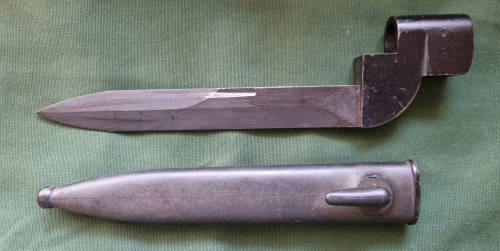



South African Pattern 9 Bayonet
Check my rate
| Main centres: | 1-3 business days |
| Regional areas: | 3-4 business days |
| Remote areas: | 3-5 business days |




| Main centres: | 1-3 business days |
| Regional areas: | 3-4 business days |
| Remote areas: | 3-5 business days |
South African Pattern 9 Bayonet
Condition as per pictures.
Local postage @ R99 PostNet to PostNet or as arranged.
Information from www.worldbayonets.com/Bayonet_Identification_Guide/South_Africa/South_Africa_2.html
Socket bayonet for use with the .303 caliber Lee-Enfield No. 4 rifle. The South African blade profile differs significantly from the British No. 9 Mk. I.
The bayonets were made by Armaments Corporation of South Africa (ARMSCOR), Lyttelton Engineering Works, in Pretoria. ARMSCOR is the State-owned arms manufacturer in South Africa.
According to Skennerton, the bayonets were made up in the 1960's using blades salvaged from FN-made Uzi submachine gun bayonets (known in So. Africa as the S1 bayonet). However, it has not been conclusively documented whether old S1 blades were actually used or whether the S1 blade was just copied. The blade attaches to the socket with two steel pins.
I was able to acquire an unassembled Uzi bayonet blade from a seller in Tel-Aviv, Israel, to compare with the S.A. No. 9. The Uzi blade is dimensionally identical to the blade of my S.A. Pattern No. 9, as shown in this comparison image. A close study also shows that, if the blade were used for the S.A. No. 9, the forward grip hole would need to be welded and ground flat, then two new holes machined for pinning the Uzi blade to the No. 9 socket. This also substantiates that it is entirely plausible that salvaged Uzi blades could have been used for manufacturing the S.A. No. 9 bayonet.
The British No. 5 Mk. I scabbard would not work with the So. African No. 9 blade, so other scabbards were substituted. There was no dedicated S.A. No. 9 scabbard.
The nylon multipurpose R1 scabbard was also used with the So. Africa No. 9 bayonet.
